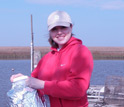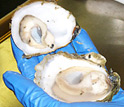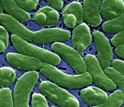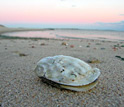News Release 10-104
NSF Awards Rapid Response Grant for Study of Vibrio Bacteria in Gulf Oyster Beds
Scientists are investigating impact of oil spill on vibrios and their antibiotic association with phytoplankton
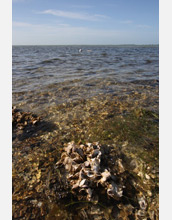
The Gulf of Mexico has long supported extensive oyster beds and a thriving oyster harvest.
June 21, 2010
This material is available primarily for archival purposes. Telephone numbers or other contact information may be out of date; please see current contact information at media contacts.
Mississippi Sound. Port Fourchon. Cocodrie.
Three places among dozens in the Gulf of Mexico where oyster beds have thrived.
How are the oysters faring with the oil spill? The National Science Foundation (NSF) has awarded a rapid response grant to scientists Crystal Johnson, Gary King and Ed Laws of Louisiana State University (LSU) to find out.
The researchers will look at how the abundance and virulence of naturally-occurring bacteria called Vibrio parahaemolyticus and Vibrio vulnificus, often found in oyster beds, may change in response to the spill.
The findings will provide insights into vibrios' ability to "consume" oil, and will allow the biologists to uncover antibiotic compounds in certain species of phytoplankton that live in association with vibrios.
"Adaptation to the spilled oil may result in an increase in some types of vibrios," says Johnson. "We believe that vibrios will change in response to the stress of direct exposure to oil and/or to indirect effects of interactions with other species affected by oil."
Vibrios are carried by and cause disease in many marine animals, including crabs, shrimp, crawfish and oysters, but the vast majority of the bacteria are harmless--and may even help break down the components of the oil.
"Little is known about how microbes--in the water, along coasts, and associated with other species--are affected by the spill," says Phillip Taylor, acting director of NSF's Ocean Sciences Division.
"Through this NSF rapid response grant, these scientists will be able to track the oil's effects on marine species living in the Gulf, and by extension, the possible threat to human health."
Several types of vibrios cause disease in humans, including gastroenteritis and, by infecting open wounds, septicemia or blood infections.
Through an existing NSF Ecology of Infectious Diseases (EID) grant, the researchers are identifying environmental factors favorable to the presence and transmission of pathogenic, or disease-causing, vibrios.
"The work will make it possible to more precisely predict when levels of these bacteria are high," says Sam Scheiner, director of NSF's EID Program.
In the rapid response grant, the team is building on a database already developed through collecting samples for the EID project.
"We're comparing the response of microbes and oysters to water quality before and after the spill," says Johnson.
Vibrios form specific associations with phytoplankton such as diatoms and algae, says King.
"Oil-induced changes in phytoplankton community composition and their associated bacterial communities are related to changes in vibrio abundance," he says.
Some species of phytoplankton in Louisiana and Mississippi coastal waters may excrete antibiotics that inhibit the growth of vibrios, according to Laws.
"We're trying to find out how widespread this may be," Laws says, "and to isolate and identify these antibiotics. The results eventually may lead to use of the compounds in the treatment of vibrio infections."
Oysters in Mississippi Sound, Port Fourchon and Cocodrie may be able to tell us about much more than oil.
This NSF grant is one of many Gulf oil spill-related rapid response awards made by the federal agency. NSF's response involves active research in social sciences, geosciences, computer simulation, engineering, biology, and other fields. So far, the Foundation has made more than 60 awards totaling nearly $7 million.
-NSF-
-
Scientist Crystal Johnson streaks vibrios for isolation on agar using a sterile loop.
Credit and Larger Version -
LSU graduate student Erica Simmons collects water, sediment and oysters in Cocodrie, La.
Credit and Larger Version -
Biologists are studying vibrios found in Gulf coast oyster beds.
Credit and Larger Version -
Vibrio vulnificus lives in warm seawater and is "halophilic"--requiring salt.
Credit and Larger Version -
Oysters and oyster beds are among the most threatened marine species and habitats.
Credit and Larger Version
Media Contacts
Cheryl Dybas, NSF, (703) 292-7734, email: cdybas@nsf.gov
The U.S. National Science Foundation propels the nation forward by advancing fundamental research in all fields of science and engineering. NSF supports research and people by providing facilities, instruments and funding to support their ingenuity and sustain the U.S. as a global leader in research and innovation. With a fiscal year 2023 budget of $9.5 billion, NSF funds reach all 50 states through grants to nearly 2,000 colleges, universities and institutions. Each year, NSF receives more than 40,000 competitive proposals and makes about 11,000 new awards. Those awards include support for cooperative research with industry, Arctic and Antarctic research and operations, and U.S. participation in international scientific efforts.
Connect with us online
NSF website: nsf.gov
NSF News: nsf.gov/news
For News Media: nsf.gov/news/newsroom
Statistics: nsf.gov/statistics/
Awards database: nsf.gov/awardsearch/
Follow us on social
Twitter: twitter.com/NSF
Facebook: facebook.com/US.NSF
Instagram: instagram.com/nsfgov


